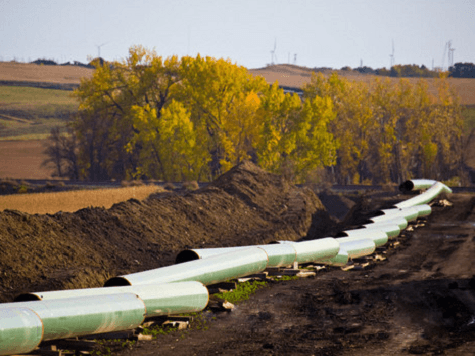After six years of dithering, the Keystone pipeline project has finally cleared both the Senate and the House with strong bipartisan support—mere percentage points away from a veto-proof majority. Now it goes to the White House where President Obama has vowed to veto it.
The Keystone pipeline should have never been an issue in Congress. Because it crosses an international border, the pipeline requires the approval of the State Department—not the president. However, since the secretary of state—first Hillary Clinton and now John Kerry—serves at the pleasure of the president, neither would buck a dictate from the White House (even if she or he had a mind to).
With millions of miles of pipeline already traversing the country and dozens already crossing the U.S.-Canada border—not to mention the “almost universal” support of the American public, the Keystone pipeline should never have made news, except that Obama’s environmental base (made up, according to Pew Research, of “solid liberals”) has made it the literal line in the sand, by which he can burnish his environmental legacy.
Within the President’s base, only two groups feel strongly about the Keystone pipeline—the unions want it, the environmentalists don’t. Each has pressured him to take its side.
I’ve likened the conflict to the classic cartoon image of a devil on one shoulder prodding an activity saying, “Oh it will be fun, everyone is doing it,” vs. the angel on the other warning, “be careful, you’ll get into trouble.” Only in the battle of the pipeline, the opposing sides have been in his pockets—environmental groups threatened to pull support from Obama’s 2012 re-election bid if he had approved Keystone. (Remember, billionaire activist Tom Steyer promised $100 million to candidates in the 2014 midterms who opposed Keystone.)
Trying to appease both sides, the president resisted taking a stand. Instead of a firm “yes” or “no,” he has avoided a decision that would ultimately anger one side or the other. First, the problem arose of the pipeline crossing over the aquifer—so it was re-routed. Next, it was held up in the Nebraska Supreme Court—but, that received a favorable resolution. Waiting for the State Department’s fifth Environmental Impact Statement (EIS) provided another delay. When the EIS finally came out, it declared the project would have minimal environmental impact and that it would produce the least amount of greenhouse gasses of any other alternative transportation method. Now Obama says Congress needs to let the State Department’s approval process play out—though no one knows when that might occur.
The labor unions, which want some of the 42,000 jobs the State Department projects grow increasingly impatient.
In 2012, the Laborers’ International Union of North America (LIUNA) broke ranks from a long-standing relationship with green groups over the Keystone pipeline and pulled out of the BlueGreen Alliance. LIUNA President Terry O’Sullivan said of his fellow union leadership: “We’re repulsed by some of our supposed brothers and sisters lining up with job killers like the Sierra Club and the Natural Resources Defense Council to destroy the lives of working men and women.”
Having its epiphany later, after the 2014 midterms, the AFL-CIO President Richard Trumka, according to the Washington Examiner, cited economic benefits and “urged the new Republican-controlled Congress and the White House to get together and approve the controversial, long-delayed Keystone XL pipeline project.”
Finally, last month, James P. Hoffa, president of the International Brotherhood of Teamsters, penned an op-ed pushing the president to approve the pipeline. In it, he calls the administration’s Keystone pipeline veto threat “passing on an opportunity to create jobs.”
Representative Donald Norcross (D-NJ), citing “the economic woes he heard about from voters while campaigning,” voted with the Republicans for the third time in the February 11 House vote. In a column for The Record, Herb Jackson explained: “One reason some Democrats broke with environmentalists on the project is its support from organized labor.” Prior to running for Congress, Norcross was assistant business manager of Local 351 of the International Brotherhood of Electrical Workers. Jackson reports: “Building trades unions were the most generous group contributing to his [Norcross] campaign.”
Norcoss’ crossing over exhibits the divide in the Democrat Party: unions vs. environmentalists. When it comes to lawmakers for whom the union vote is important, Keystone wins.
Once the bill is vetoed, it goes back to Congress where it must be “reconsidered”—which means it can be voted on again or can go back to committee where some adjustments may be made that will make it more attractive to members, who didn’t vote on it the first time around.
Because the Senate and the House have both voted, which Democrats voted against the bill is also well known—many of those Democrats represent heavily unionized districts.
To override the presidential veto, 5 more votes are needed in the Senate (Marco Rubio wasn’t present during the January 29 vote and would be assumed to be a “yes” vote, meaning only 4 Democrats need to be swayed.), in the House, about 12.
With some arm twisting from the unions, those additional votes shouldn’t be all that difficult to come by and the Keystone XL pipeline can finally move forward—providing Americans with thousands of good-paying jobs and increased energy security. Meanwhile, President Obama will have made his position perfectly clear.
The author of Energy Freedom, Marita Noon serves as the executive director for Energy Makes America Great Inc. and the companion educational organization, the Citizens’ Alliance for Responsible Energy (CARE). She hosts a weekly radio program: America’s Voice for Energy—which expands on the content of her weekly column.

COMMENTS
Please let us know if you're having issues with commenting.